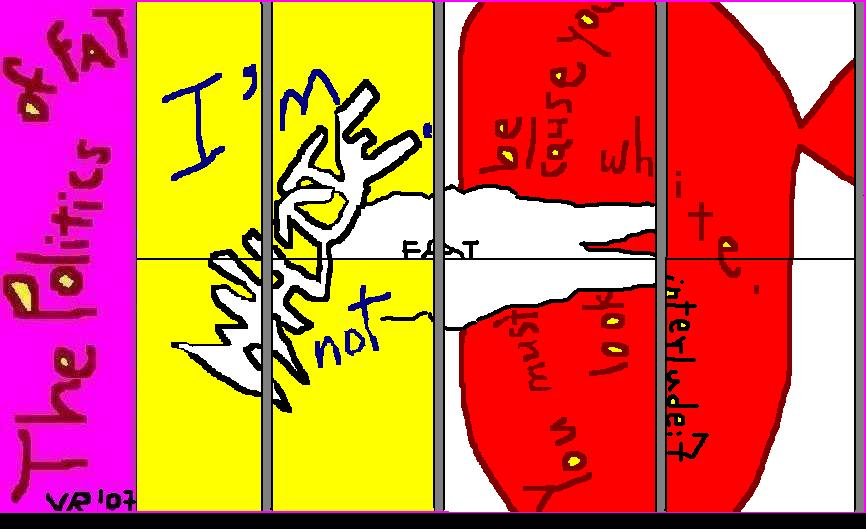|
A shorter but also different view on comics that I wish to share:
The textual world assumes priority over other forms of literature. In this world, we privilege great works of literature
defined by particular eras, and then chart them in bibliographic records. One can locate a title from centuries ago, others
of which are similarly archived and, more recently, becoming accessible in digitized formats. We can also identify them by
genre, character and/or theme. Comics, however, remain largely on the periphery.
What markedly defines a comic is the admixture of image and text to tell a story; in the case of wordless comics, what
defines them as comics is the sequence of images to show a particular story (which is problematic when you consider that a
traditional museum display is similarly represented since the group of art pieces shown are not randomly assigned and usually
include captions, making them, very broadly defined, comics). Yet comics also define particular modes of storytelling and
can likewise be found subdivided among classifications of fiction and nonfiction, superhero and non-superhero.
Graphic novels, which denote novella-length comic books (in which the storyline is more cohesive, fuller and longer
than traditional comics), also equate with fictional stories. Nonfiction contributions by comics artists such as Marjane Satrapi
(Persepolis, Embroideries), on the other
hand, can now be found in the Biography section, though these are also graphic novels.
Part of the problem has been the increase in manga and related comics from Japan
and outlying areas, which are more extensively fiction. In the United
States, the market remains dominated by superhero comics, which are also fiction.
What is perhaps different today from even the late 1980s is that more traditional publishers like Pantheon
Books are starting to get into lines of serious comics, that is, nonfiction. For that
reason, comics published by Art Spiegelman (more known for Maus among mainstream
consumers), Joe Sacco (Palestine, Safe Area Gorazde), Joe Kubert (fax from sarajevo), and David B. (Epileptic)
are finding spaces in traditional (non-comics) categories.
At the
same time, it is not always easy to distinguish between fictional and nonfictional graphic novels unless these are explicitly
expressed (i.e., by the publisher, comics artist). There are also comics artists
whose works, though not entirely autobiographical, take their cues from the writers’ and/or artists’ (in the case
of collaborations) experiences.
More
important, one cannot always find earlier serious comics using traditional search engines. For example, I did not know about
Madison Clell’s autobiographical Cuckoo, which is marked as Biography/Psychology
(and not as a comic), until Maria at Last Gasp of San Francisco told me about it.
A Select List of My Comics
American Elf: the collected sketchbook
diaries of James Kochalka: October 26, 1998 to December 31, 2003. Top Shelf Productions, 2004.
Arnoldi, Katherine. The Amazing "True
Story" of a Teenage Single Mom. Hyperion, 1998.
Barry, Lynda. One! Hundred! Demons!
Seattle: Sasquatch Books, 2002.
Delisle, Guy. Journey to Pyongyang.
Drawn & Quarterly, 2005.
Doherty, Catherine. Can of Worms. Fantagraphics Books, 2000.
Jason. Hey, Wait...Fantagraphics
Books, 2004 (2001).
Myrick, Leland. Missouri Boy. First
Second, 2006.
Ward, Lynd. Gods' Man: A Novel in Woodcuts.
Dover Publications, 2004 (Jonathan Cape and Harrison Smith, Inc., 1929).
|
 |
|
Here are some ideas (abbreviated) that I wanted to
articulate at the 2005 Vernacular Colloquium Conference:
1. What is it about text and images that makes the comics format
unique? If a synergism exists between the languages of reading and seeing (or visualization, which also
has to be "read") that creates a particular experience between the writer/artist and reader, then what is the function
of that relationship? More important, what goes into the process of coding what a stranger understands about the personal
experiences of the autobiographical comic/graphic novel?
It is a problem, first, of making the image work with the text.
What is left out of the image needs to be found in the text and vice versa; otherwise, the comic risks being overtly
descriptive, taking on the form more of a picture book than a comic. If we understand a comic to be simply composed
of pictures and words, then the overgeneralization allows for any combination of images and text to be defined as a comic.
2. Photojournalism is more closely a comic than anything else,
especially when it features a montage of images designed around a specific story; however, a comic may also be comprised of
a single panel, which makes its categorization more difficult. The fine line between photojournalism and comics is the rope
game of the real versus the imaginary. Even so, you will sometimes find photos as part of the comics story (i.e., in Maus),
which seems to challenge the construction of the real. That is, while a photograph may reveal more similitude between the
actual and its reproduction (see Barthes), it, too, exposes a fictive product, one manipulable by the photographer and his
or her equipment.
3. The autobiographical comic, which proposes to uncover some aspect
of the writer/artist's past, too easily gets cast as a fiction. Despite studies in autobiography that challenge the truth
of personal history, the comics format invites skepticism because, despite McCloud's claim that iconography allows the reader
to assume the identity of the icon because its nonrepresentation intrudes a self-representation, the reader is unable to imagine
him- or herself as the "I" in the autobiogaphical comic.
That is due in part to the position of comics as fiction in
mainstream America. I think one reason Spiegelman's Maus gets so much academic attention is because it insists on
being nonfiction; its association with the phrase graphic novel also glamourizes it as novel and different, despite the
fact that a lot of comics, even when marketed as fiction (especially those of the underground), are autobiographically-based.
Although Maus did not revolutionze comics, it entered the publishing world at around a time when American comics
began to mature.
4. I do not mean to suggest that comics before Maus were
immature, but that the sophistication of the form as a medium for nonfiction is what makes the autobiographical comic today
undefined as a comic per say, which is why these can be found in bookstores under the term Biography than Graphic Novels.
The first story in Eisner's A Contract with God, a collection of four short comics stories, is based
partly on his experiences of losing his daughter to leukemia, but it is not nonfiction the way Maus is nonfiction.
Spiegelman did not simply write a story about his father, Vladek's, experiences in the Nazi camps, but he corroborated that
story with other survivor experiences, making Maus a larger nexus between biography and history.
5. Although the Vietnam War sparked a response in the underground
comix movement, that movement was also set off by the 1954 Comics Code, which created a different environment for
comics than the one that surfaced with the introduction of adult comics (see Sabin) in the 1980s. If the 1954 Comics Code
(see especially Kiste Nyberg) interfered with the evolution of comics, it is possible that what is observable about contemporary
comics today would have been true of comics in the 1960s - assuming the absence of the 1954 Comics Code. What I
am suggesting is that autobiographical comics then would have meant that they were part of the canon now.
© Vanessa
Raney 2005
|
|
 |
|
I made these comments at different times to the comix listserv:
A book on the Staff Recommended shelf by Sonja Ahlers, titled Fatal Distraction (2004),
I have no idea what to make of it. It uses both image and text but I don't know if it's a collection of random sketches or
autobiograhical in some way or entirely fiction, etc. However, it raises questions about what defines a comic - does a comic
differ specifically because it has words and pictures? Because I know there are wordless comics, but these are sequenced.
Does a combination of random pictures and words fit the definition of comics? If you look at the history of comics, the later
prototypes (nineteenth century specifically, though McCloud (and I believe Eisner in his earlier work that precedes McCloud,
though McCloud gets a lot of the credit for suggesting a specific language of comics) also makes the argument that hieroglyphics,
too, could be construed as one of the earlier forms because of the way the pictures are sequenced - which almost makes you
need to accept them if you affirm that wordless comics are indeed comics) in which captions were added to image are legitimate
forms of comics, then is her work a comic? It makes me then wonder about picture books - couldn't these, too, be considered
comics? Can anyone help with this - is a comic defined more by form or what? Because then, couldn't picture books, illustrations
in the New Yorker and other periodicals, etc. be classified as comics?
The question of art or literature really reflects the ambiguous structure of the comic, which depends
on two simultaneous languages (Neil Cohn focusing on visual language) that, when the form really works and solidifies, depends
on both image AND text to tell the story. However, I've seen a lot of comics in which the images just show, not relate. However,
that is also true of a lot of literature, of which some is character-driven and others plot-driven, where you have conventions
in genre and literary writing, etc. The comic is no exception, but even then, it's confused. When the comic no longer gets
defined as a comic (for example, when I asked about Marjane Satrapi's Embroideries at Bookstop, I was told it was
Biography, not a Graphic Novel because for this store, graphic novels equated with fiction so what you saw in that section
were superhero comics, manga and Neil Gaiman, who's doing story), then you have a more pressing need to examine why certain
comics are being taken more seriously and appreciated as stories (as opposed to show and tell). I don't know where Eisner
fits in this, since I think it's fair to say that he's known more among comics readers/scholars/etc. as a serious comics artist
than among mainstream, though this may be changing.
Even so, the final product assumes a specific kind of definition that, when examined as an artifact that results from
specific social interactions and societal impulses, demands a different kind of analysis. However, it is the final label that
defines its processes more narrowly. What made comics more popular since Maus (and Dark Watchmen and the
one before that I can never remember offhand) - many (such as Roger Sabin) argue that it was the media hype of the word graphic
novel that commanded a different attitude, which I would argue is what's responsible for the current demand for graphic novels:
essentially comics made into books (novellas, for the most part). So now you see a wide assortment of comics serials being
republished as graphic novels, while works intended as graphic novels (long thematically-focused books) get jumbled in
with this. It reflects both an economic demand and a social context; comics are more "in" (so one could argue, though I don't
know how convincing this would actually be) because of the form. Even the superhero genre has found (maybe further than the
1980s) its way into graphic novel formats. Even newspaper comics are being thus recontexted.
|
 |
 |
|
|
|


